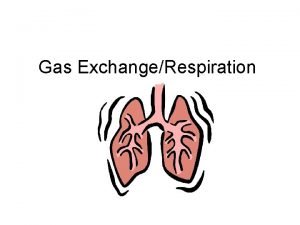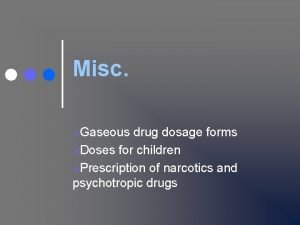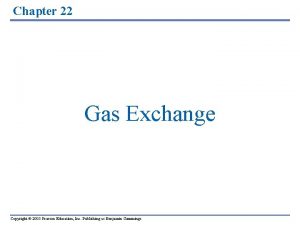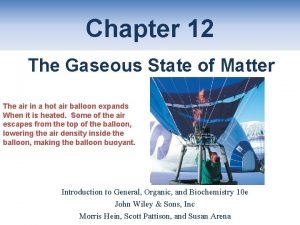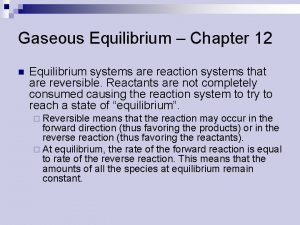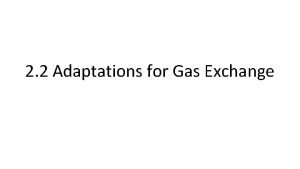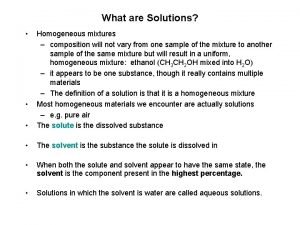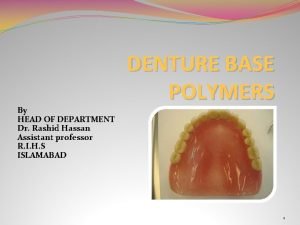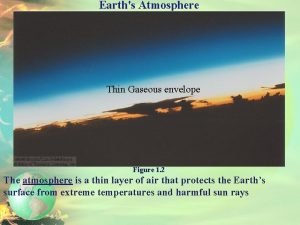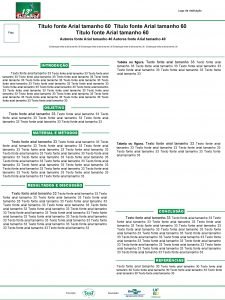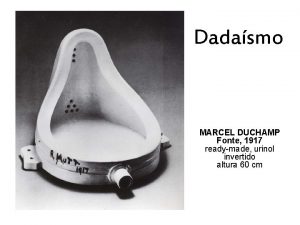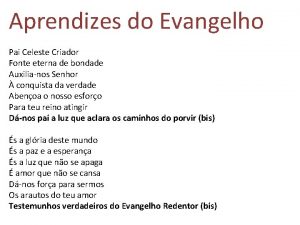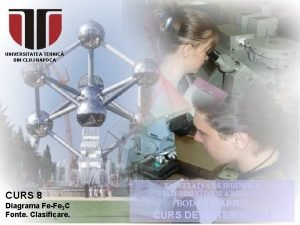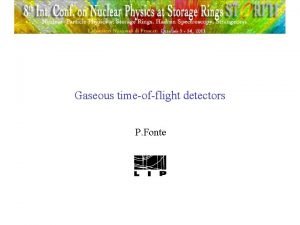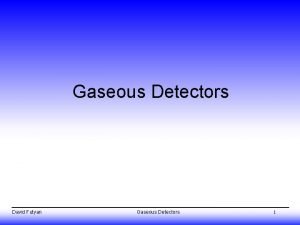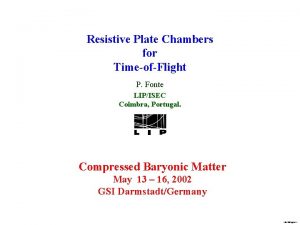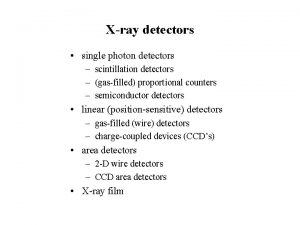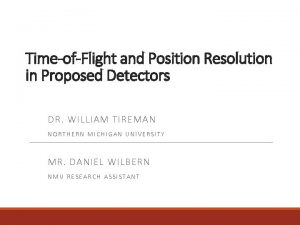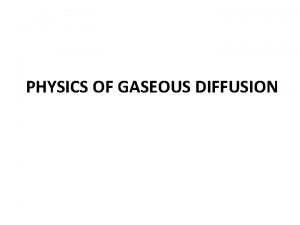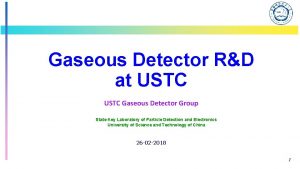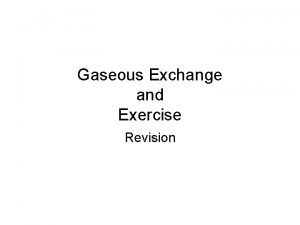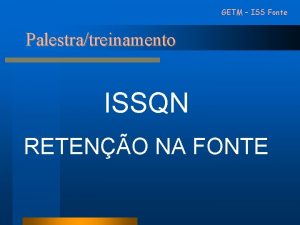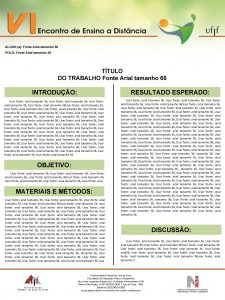Gaseous timeofflight detectors P Fonte STORI 11 Gaseous













![STORI’ 11 Gaseous time-of-flight detectors P. Fonte [ Fonte 2000] Example: Small single counters STORI’ 11 Gaseous time-of-flight detectors P. Fonte [ Fonte 2000] Example: Small single counters](https://slidetodoc.com/presentation_image/1105e15922e33e57ec3edd94766052cc/image-14.jpg)
![STORI’ 11 Gaseous time-of-flight detectors P. Fonte [S. An, 2008] Example: 24 gap multigap STORI’ 11 Gaseous time-of-flight detectors P. Fonte [S. An, 2008] Example: 24 gap multigap](https://slidetodoc.com/presentation_image/1105e15922e33e57ec3edd94766052cc/image-15.jpg)


![STORI’ 11 Gaseous time-of-flight detectors Charge spectra [Fonte 1999] Measured single-gap fast (electronic component) STORI’ 11 Gaseous time-of-flight detectors Charge spectra [Fonte 1999] Measured single-gap fast (electronic component)](https://slidetodoc.com/presentation_image/1105e15922e33e57ec3edd94766052cc/image-18.jpg)








![STORI’ 11 Gaseous time-of-flight detectors P. Fonte [M. Kis, CBM coll. meeting 2008] Example: STORI’ 11 Gaseous time-of-flight detectors P. Fonte [M. Kis, CBM coll. meeting 2008] Example:](https://slidetodoc.com/presentation_image/1105e15922e33e57ec3edd94766052cc/image-27.jpg)
![STORI’ 11 Gaseous time-of-flight detectors P. Fonte [Schuetauff, 2006] Example: FOPI’s multistrip multigap (MMRPC) STORI’ 11 Gaseous time-of-flight detectors P. Fonte [Schuetauff, 2006] Example: FOPI’s multistrip multigap (MMRPC)](https://slidetodoc.com/presentation_image/1105e15922e33e57ec3edd94766052cc/image-28.jpg)


![STORI’ 11 Gaseous time-of-flight detectors P. Fonte [Wang et al. , IEEE NSS 2010] STORI’ 11 Gaseous time-of-flight detectors P. Fonte [Wang et al. , IEEE NSS 2010]](https://slidetodoc.com/presentation_image/1105e15922e33e57ec3edd94766052cc/image-31.jpg)





![STORI’ 11 Gaseous time-of-flight detectors P. Fonte [Gonzalez-Diaz, talk at IEEE NSS 2009] Multihit STORI’ 11 Gaseous time-of-flight detectors P. Fonte [Gonzalez-Diaz, talk at IEEE NSS 2009] Multihit](https://slidetodoc.com/presentation_image/1105e15922e33e57ec3edd94766052cc/image-37.jpg)


- Slides: 39

Gaseous time-of-flight detectors P. Fonte

STORI’ 11 Gaseous time-of-flight detectors Outlook • The timing RPC • Detector physics • avalanche physics • time resolution • number of gas gaps • choice of gas gap width • importance of space-charge • Readout issues • Signal and electronics • Pads vs. strips • Crosstalk • Conclusion P. Fonte

STORI’ 11 Gaseous time-of-flight detectors P. Fonte The timing RPC detector technology Resistive material, glass • Timing resolution ~ 50 ps σ. Sensitive Area MIPS • No energy resolution. • Possibility to measure the position. • No sparking (only small local discharges called “streamers”) Particle E Conductive material, Aluminum Main features • Efficiency 75% for a 300 μm gap -HV Gas gap Precise gas gap with few 100 m

STORI’ 11 Gaseous time-of-flight detectors P. Fonte Main timing RPC applications (since 2000) All practical t. RPCs in operation are “multigap” [ Williams 1996] and symmetric, use a gas mixture composed of C 2 H 2 F 4, SF 6 and eventually C 4 H 10 in various proportions. Except HARP, all detectors show a time resolution between 40 and 80 ps and efficiency >97% (details may depend also on the measurement setup). Gap Width Nr of gaps Readout structure 300 µm 2+2 64 pads 2. 9 x 10. 4 cm 2 ALICE@CERN STAR@BNL 220 µm 5+5 2 x 48 pads 2. 5 x 3. 7 cm 2 FOPI@GSI 220 µm 4+4 16 strips 2. 8 mm pitch HADES@GSI 270 µm 2+2 monostrip PANDA@GSI ? ? ? CBM@GSI ? ? multistrip symmetric multigap RPC HV Concluded experiments HARP@CERN Physics production In study Timing RPC: a revolution in TOF technology for High. Energy and Nuclear physics

STORI’ 11 Gaseous time-of-flight detectors P. Fonte Detector physics 2 main questions: 1 -How is it possible to reach 50 ps resolution in a gas counter? 2 -How is it possible to reach efficiencies of 75% in a 0. 3 mm gas gap? Enormous space-charge effect

STORI’ 11 Gaseous time-of-flight detectors P. Fonte Time resolution-basics i cathode anode i Detection level independent from the cluster position exact timing (If no primary statistics or avalanche statistics)

STORI’ 11 Gaseous time-of-flight detectors P. Fonte Time resolution-basics i cathode anode i [Werner Riegler, Elba, 2003] Several clusters (Poisson distribution) Detection level Time needed to reach a independent from given current depends on the cluster position avalanche growth statistics (exponential distribution). exact timing (If no primary statistics or avalanche statistics)

STORI’ 11 Gaseous time-of-flight detectors P. Fonte Time resolution-basics i cathode Time needed to reach a given current depends on avalanche growth statistics (exponential distribution). Several clusters (Poisson distribution) anode i i 0

STORI’ 11 Gaseous time-of-flight detectors Time resolution-basics P. Fonte analytical model i cathode Detection level Time needed to reach a independent from given current depends on the cluster position avalanche growth statistics (exponential distribution). exact timing (If no primary statistics or avalanche statistics) Several clusters (Poisson distribution) anode i i 0 [Mangiarotti, Fonte and Gobbi, RPC 2003]

STORI’ 11 Gaseous time-of-flight detectors P. Fonte Time resolution - analytical model Slope= *vd i 0 The i 0 distribution is translated into a time distribution by action of the [Mangiarotti, Fonte and Gobbi, RPC 2003] discriminating level. Single-cluster Basic time scale: ~100 ps. The time resolution depends essentially on 2 parameters: -linearly on 1/( *vd) = average time between ionizing colisions -on the average number of effective clusters (r n 0)

STORI’ 11 Gaseous time-of-flight detectors P. Fonte Time resolution - analytical model Universal curves • The resolution is a function of the ineficiency only • Asymptotic 1/ (N) behaviour Observable resolution should be somewhat better, as the time somewhat intrinsically correlates with charge (on top of the trivial electronics risetime effect) and can be corrected.

STORI’ 11 Gaseous time-of-flight detectors P. Fonte Example: 2 D-position sensitive readout HV Precise construction Time signal 2 mm thick black glass lapped to ~1 m flatness X right X left 4 cm XY readout plane RC passive network 10 strips for each coordinate at 4 mm pitch out left Y-strips (on PCB) 300 m thick high glass disk (corners) Well carved into the glass (avoid dark currents from the spacer) [Blanco 2002] metal box (no crosstalk) Resistive division out right RC passive network X-strips (deposited on glass) (for small and accurate TOF systems)

STORI’ 11 Gaseous time-of-flight detectors Y(mm) Events/mm 2 Events/0. 5 mm Example: 2 D - position-sensitive Position resolution X (mm) 10 Sigma= 74. 0 ps (62 ps) Center 1 0 10 -1000 Events/4 ps 10 2 1500 10 10 2 1 Trigger edge (3 mm) 1000 Chamber edge 500 0 -25 -20 -15 -10 -5 0 5 10 15 20 25 Position along X (mm) 1500 4 mm strip pitch 1000 500 ( =75%) No edge effects P. Fonte 0 -25 -20 -15 -5 0 5 10 15 Position along Y (mm) Sigma= 76. 9 ps (66 ps) Edge & Corner -10 edges 3 mm resolution 3 mm FWHM (strips=4 mm) 0 -500 0 500 Time difference (ps) 1000 10 -1000 -500 0 500 Time difference (ps) 1000 [Blanco 2002]
![STORI 11 Gaseous timeofflight detectors P Fonte Fonte 2000 Example Small single counters STORI’ 11 Gaseous time-of-flight detectors P. Fonte [ Fonte 2000] Example: Small single counters](https://slidetodoc.com/presentation_image/1105e15922e33e57ec3edd94766052cc/image-14.jpg)
STORI’ 11 Gaseous time-of-flight detectors P. Fonte [ Fonte 2000] Example: Small single counters (9 cm 2) 4 x 0. 3 mm gaps Aluminum Glass -HV Resolution of the reference counter = 99. 5 % for MIPs (75%/gap) 3 (optimum operating point 1% of discharges)
![STORI 11 Gaseous timeofflight detectors P Fonte S An 2008 Example 24 gap multigap STORI’ 11 Gaseous time-of-flight detectors P. Fonte [S. An, 2008] Example: 24 gap multigap](https://slidetodoc.com/presentation_image/1105e15922e33e57ec3edd94766052cc/image-15.jpg)
STORI’ 11 Gaseous time-of-flight detectors P. Fonte [S. An, 2008] Example: 24 gap multigap RPC Single-point measurement between identical counters. All systematic errors cancel out.

STORI’ 11 Gaseous time-of-flight detectors What is the real advantage of many gas gaps? • More efficiency: YES. 1 -(1 -0. 75)N (single gap=75%) • Better timing: YES. ~1/ N • Larger signal? • Better charge spectra? P. Fonte

STORI’ 11 Gaseous time-of-flight detectors P. Fonte Induced signal strenght vs. geometric dimensions qind = fast (electronic) induced charge: the useful signal No real advantage in having many or wider gaps i(t) Q 3(t) Q 2(t) d g Q 1(t) For a regular structure (all d’s and g’s the same) r =relative permittivity of the glass ~4 Ew is the “weighting field”, which accounts for the coupling (electrical induction) between the avalanche charges and the electrodes 1/ln(G) is related to the details of the avalanche development. This is a complex matter, but experimentally a value of 1/10 is often found g is the gap width d is the glass thickness
![STORI 11 Gaseous timeofflight detectors Charge spectra Fonte 1999 Measured singlegap fast electronic component STORI’ 11 Gaseous time-of-flight detectors Charge spectra [Fonte 1999] Measured single-gap fast (electronic component)](https://slidetodoc.com/presentation_image/1105e15922e33e57ec3edd94766052cc/image-18.jpg)
STORI’ 11 Gaseous time-of-flight detectors Charge spectra [Fonte 1999] Measured single-gap fast (electronic component) charge spectrum P. Fonte 4 -fold convolution of a single-gap spectrum superimposed on the measured 4 -gap spectrum 4 -fold convolution Space-charge gain limit N-fold convolution gaussian [Akindinov et al. 2004] measured 10 -gap spectrum

STORI’ 11 Gaseous time-of-flight detectors P. Fonte What is the real advantage of many gas gaps? • More efficiency: YES. 1 -(1 -0. 75)N (single gap=75%) • Better timing: YES. ~1/ N • Larger signal: NO. The increase in the generated charge is compensated by the larger distance to the readout electrodes • Better charge spectra: YES. Tends to gaussian.

STORI’ 11 Gaseous time-of-flight detectors What gas gap width? P. Fonte Single-cluster • The higher the gain the better because the ionization rate v sets the time scale • Limitation: too many streamers • Smaller gaps require higher v for the same gain (favourable) Basic time scale: ~100 ps. • Furthermore, in a small gap a large v results on a comparatively small avalanche owing to the space-charge effect, avoiding disturbing streamers. (Very hard effect to calculate. ) • Empirical optimum 200 to 300 µm theor etica l ~1/Q Space-charge effect

STORI’ 11 Gaseous time-of-flight detectors Readout issues P. Fonte

STORI’ 11 Signal characteristics Gaseous time-of-flight detectors P. Fonte

STORI’ 11 Gaseous time-of-flight detectors Electrode shape P. Fonte Distribution of position-time jitter PADS: 2 n geometry (ALICE TOF) HARP (analog sum) time jitter Usable up to ~100 mm wide pads Possible further problem: large geometrical and impedance mismatch may lead to excessive signal loss Impact on gaussian resolution

STORI’ 11 Gaseous time-of-flight detectors P. Fonte Electrode shape STRIPS: introduced in the famous Pestov counter Solves the problem because: average time (between ends) is independent from the particle position (TOF) difference time is independent from TOF and gives the particle position

STORI’ 11 Gaseous time-of-flight detectors P. Fonte Example: Large t. RPC counter Active area = 10 cm 160 cm = 0. 16 m 2 (400 cm 2/electronic channel) 1, 6 m HV 5 cm 4 timing channels Top view Cross section Ordinary 3 mm “window glass” [Blanco 2001] Copperstrips

STORI’ 11 Gaseous time-of-flight detectors P. Fonte Example: Large t. RPC counter Efficiency and time resolution 100% = 95 to 98 % 98% 97% 96% Strip A 95% Strip B 94% 93% -80 -70 -60 -50 -40 -30 -20 -10 Strips A+B 0 10 20 30 40 50 60 70 80 Time resolution (ps ) Center of the trigger region along the strips (cm) 100 90 = 50 to 75 ps [Blanco 2001] Time efficiency 99% 80 70 60 50 40 -80 -70 -60 -50 -40 -30 -20 -10 0 10 20 30 40 50 60 70 80 Center of the trigger region along the strips (cm) No degradation when the area/channel was doubled (800 cm 2/channel)
![STORI 11 Gaseous timeofflight detectors P Fonte M Kis CBM coll meeting 2008 Example STORI’ 11 Gaseous time-of-flight detectors P. Fonte [M. Kis, CBM coll. meeting 2008] Example:](https://slidetodoc.com/presentation_image/1105e15922e33e57ec3edd94766052cc/image-27.jpg)
STORI’ 11 Gaseous time-of-flight detectors P. Fonte [M. Kis, CBM coll. meeting 2008] Example: FOPI’s multistrip multigap (MMRPC) 16 strips, exactly 50 impedance, readout from both sides
![STORI 11 Gaseous timeofflight detectors P Fonte Schuetauff 2006 Example FOPIs multistrip multigap MMRPC STORI’ 11 Gaseous time-of-flight detectors P. Fonte [Schuetauff, 2006] Example: FOPI’s multistrip multigap (MMRPC)](https://slidetodoc.com/presentation_image/1105e15922e33e57ec3edd94766052cc/image-28.jpg)
STORI’ 11 Gaseous time-of-flight detectors P. Fonte [Schuetauff, 2006] Example: FOPI’s multistrip multigap (MMRPC) Unfortunately, no multihit data has been published

STORI’ 11 Gaseous time-of-flight detectors P. Fonte Strips: the crosstalk problem Crosstalk amplitude in 2 -strips approximation Inducto-capacitive coupling Depends essencially on the self and mutual capacities (Cm, Cg) and on the same with the dielectrics removed (Cm 0, Cg 0). Modal-dispersion coupling [Gonzalez-Diaz 2011] In a multiconductor transmission line (MTL) the electrodes couple via mutual capacitance and inductance. Exact theory exists. Good match with measurements.

STORI’ 11 Gaseous time-of-flight detectors Strips: the crosstalk problem BW=1. 5 GHz Rin=50 Ω very dispersive! 5 cm 1, 6 m Cg=514 p. F/m P. Fonte Cm=88 p. F/m Zc~13 Ω Cm/Cg =17% Fct=50% ! transverse scan 'fine-tunning' Fct=40% Data [Blanco 2001] Calculation [Gonzalez-Diaz, talk at IEEE NSS 2009] 80%-90% measured cross-talk levels reproduced
![STORI 11 Gaseous timeofflight detectors P Fonte Wang et al IEEE NSS 2010 STORI’ 11 Gaseous time-of-flight detectors P. Fonte [Wang et al. , IEEE NSS 2010]](https://slidetodoc.com/presentation_image/1105e15922e33e57ec3edd94766052cc/image-31.jpg)
STORI’ 11 Gaseous time-of-flight detectors P. Fonte [Wang et al. , IEEE NSS 2010] Recent results on crosstalk for CBM@GSI. . . Observable crosstalk is only a few % except for large charge (streamers) . . .

STORI’ 11 Gaseous time-of-flight detectors [I. Deppner, etal. , in press doi: 10. 1016/j. nima. 2010. 09. 165] Recent results on crosstalk for CBM@GSI Total observable crosstalk is only 2 -3%. P. Fonte

STORI’ 11 Gaseous time-of-flight detectors The “subtle” crosstalk problem P. Fonte

STORI’ 11 Gaseous time-of-flight detectors Example: shielded t. RPCs for HADES@GSI 1200 individually-shielded monostrip counters Further shielding between feedthrougs P. Fonte

STORI’ 11 Gaseous time-of-flight detectors P. Fonte Example: shielded t. RPCs for HADES@GSI Full area measurement between identical counters. Some systematic errors may cancel.

STORI’ 11 Gaseous time-of-flight detectors P. Fonte Example: shielded t. RPCs for HADES@GSI Despite extensive shielding a residual 20 ps “subtle” crosstalk effect remains No other multihit time resolution measurement is available in the literature
![STORI 11 Gaseous timeofflight detectors P Fonte GonzalezDiaz talk at IEEE NSS 2009 Multihit STORI’ 11 Gaseous time-of-flight detectors P. Fonte [Gonzalez-Diaz, talk at IEEE NSS 2009] Multihit](https://slidetodoc.com/presentation_image/1105e15922e33e57ec3edd94766052cc/image-37.jpg)
STORI’ 11 Gaseous time-of-flight detectors P. Fonte [Gonzalez-Diaz, talk at IEEE NSS 2009] Multihit resolution calculation (typical 1/20!. . . )

STORI’ 11 Gaseous time-of-flight detectors P. Fonte Multihit resolution calculation. . . [Gonzalez-Diaz, talk at IEEE NSS 2009] . . .

STORI’ 11 Gaseous time-of-flight detectors P. Fonte Conclusion • Timing RPCs are now the standard technique for TOF measurements in HEP and Nuclear Physics • Massive applications, previously impossible, were deployed and others are under study • Resolutions from 40 to 80 ps are easily reached with efficiency > 98%. • Pad readout is limited to ~10 cm wide pads owing to timing and maybe electrical limitations • Shielded monostrip readout has been shown to provide robust multihit performance at the expense of more complex mechanics • Multistrip detectors were deployed and are being further developed but their multihit time resolution in remains unproven
 Streaming current detectors
Streaming current detectors Where are feature detectors located
Where are feature detectors located Chromatography mobile phase and stationary phase
Chromatography mobile phase and stationary phase Frontier detectors for frontier physics
Frontier detectors for frontier physics Vhv voltage detectors
Vhv voltage detectors Kinesthesis and vestibular sense
Kinesthesis and vestibular sense Giant wave detectors murmurs universe
Giant wave detectors murmurs universe Diagnosing error in object detectors
Diagnosing error in object detectors Photo detectors
Photo detectors Feature vectors
Feature vectors Giant gravitational detectors hear murmurs across
Giant gravitational detectors hear murmurs across What is thermal detector
What is thermal detector Nuclear detectors
Nuclear detectors Feature detectors
Feature detectors Solar system inner and outer planets
Solar system inner and outer planets Inorganic gases
Inorganic gases Khbo2
Khbo2 Gaseous exchange in animals
Gaseous exchange in animals Gaseous exchange practical grade 11
Gaseous exchange practical grade 11 Gaseous exchange in grasshopper
Gaseous exchange in grasshopper Drug form definition
Drug form definition Gaseous dosage form
Gaseous dosage form Inorganic gaseous pollutants of air
Inorganic gaseous pollutants of air In earthworm
In earthworm Gaseous state chapter
Gaseous state chapter Gaseous equilibrium
Gaseous equilibrium Xeromorphic plants
Xeromorphic plants Are solutions homogeneous
Are solutions homogeneous At 500 k one mole of gaseous oncl
At 500 k one mole of gaseous oncl Contraction porosity denture
Contraction porosity denture Gaseous envelope of the sun
Gaseous envelope of the sun Frases dirceu gassen
Frases dirceu gassen Fonte scritta significato
Fonte scritta significato Figura fonte arial tamanho
Figura fonte arial tamanho Fonte viva natal
Fonte viva natal Getm
Getm Fonte
Fonte Marcel duchamp fonte
Marcel duchamp fonte Pai celeste criador
Pai celeste criador Clasificarea fontelor
Clasificarea fontelor



















